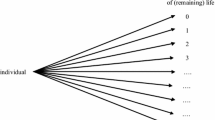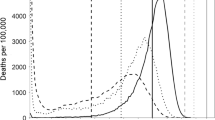Abstract
Whereas period life expectancy constitutes an intuitive indicator of the survival conditions prevailing at a particular period, this paper argues that, given the existence of welfare interdependencies, that widespread indicator is nonetheless an incomplete measure of the longevity achievements relevant for human well-being. The central importance of coexistence for human-beings implies that usual life expectancy measures should be complemented by joint life expectancy indicators, which measure the average coexistence time under particular survival conditions. After a study of the theoretical foundations of ‘single’ and ‘joint’ life expectancy indicators, it is shown that joint life expectancy measures tend to enrich significantly the comparison of longevity achievements across countries and periods. Moreover, the introduction of joint life expectancy indicators—as a complement to conventional life expectancy measures—into multi-variable indexes such as the United Nations’ HDI is also shown to affect international rankings of standards of living to a non negligible extent.








Similar content being viewed by others
Notes
A (period) life-table shows the probabilities to survive up to different ages conditionally on the vector of age-specific probabilities of death prevailing at a particular period.
Throughout this paper, what I shall call ‘welfare’ can refer either to how well people feel (i.e. subjective well-being) or to how well people are (i.e. objective well-being): whether welfare is supposed to be subjective or objective has, in the present context, no importance for the precise way in which longevity achievements should be measured.
One should notice that, as emphasized by Vaupel (1986), probabilities of death at high ages have, compared to the ones at low ages, a stronger influence on life expectancy measures.
See Friedkin (1998).
See Needleman (1976) on the empirical estimation of altruism coefficients on the basis of kidney transplant data.
On a modified version of the HDI taking inequalities into account, see Hicks (1997).
On each dimension x, the index for a country A is equal to \({\frac{x(A)-{\rm Minimum}(x)}{{\rm Maximum}(x)-{\rm Minimum}(x)}}\) . For the adult literacy rates and enrolment rates, the minimum and maximum levels are fixed to 0% and 100% (see UN 2003).
In the rest of this section, single and joint life expectancy statistics are average for both sexes. Probabilities of survival up to different ages are extrapolated from the abridged life-tables of United Nations Population Division (2005), available online at http://www.un.org/popin/data.htm..
From now, our sample excludes micro-countries, such as Monaco, Andorra, and San Marino, which are not ranked by the United Nations (see UN 2003).
References
Blanchflower, D. G., & Oswald, A. J. (2004). Well-being over time in Britain and the USA. Journal of Public Economics, 88, 1359–1386
Bongaarts, J., & Feeney, G. (2002). How long do we live? Population and Development Review, 28, 13–29
Carrière, Y., & Légaré, J. (2000). Unmet needs for assistance with ADLs and IADLs: A measure of healthy life expectancy. Social Indicators Research, 51(1), 107–124
Dasgupta, P. S. (2001). Human well-being and the natural environment. Oxford University Press
Finkelstein, L. (1982). Theory and philosophy of measurement. In: Sydenham P. H. (Eds.), Handbook of measurement science, vol 1. Wiley & Sons
Friedkin, N. E. (1998). A Structural theory of social influence. Cambridge University Press, Cambridge
Hicks, D. (1997). The inequality-adjusted human development index: A constructive proposal. World Development, 25(8), 1283–1298
Human Mortality Data Base (2005). University of California, Berkeley (USA), and Max Planck Institute for Demographic Research (Germany). Available at http://www.mortality.org (data downloaded on July 2005)
Morris, M. D. (1979). Measuring the condition of the world’s poor. Pergamon Press, Oxford
Needleman, L. (1976). Valuing other people’s lives. Manchester School, 44, 309–342
Osberg, L., & Sharpe, A. (2005). How should we measure the economic aspects of well-being? Review of Income and Wealth, 51(2), 311–336
Perenboom, R. J. M., van Herten, L. M., Boshuizen, H. C., van den Bos, G. A. M (2004). Trends in life expectancy in well-being. Social Indicators Research, 65(2), 227–244
Putnam, R. D. (2000). Bowling alone. The collapse and revival of American community. Simon & Schuster
United Nations (1990, 1994, 2003, 2005). Human development report. Oxford University Press, New York
Vallin, J., & Berlinguer, G. (2002). De la mortalité endogène aux limites de la vie humaine In: G. Casselli, J. Vallin, & G. Wunsch (Eds.), Démographie: analyse et synthèse (Vol. 3). Les déterminants de la mortalité INED, Paris
Vaupel, J. W.(1986). How changes in age-specific mortality affect life expectancy. Population Studies, 40(1), 147–157
Veenhoven, R. (1996). Happy Life-Expectancy: A comprehensive measure of quality-of-life in nations. Social Indicators Research, 39, 1–58
Author information
Authors and Affiliations
Corresponding author
Rights and permissions
About this article
Cite this article
Ponthiere, G. Measuring longevity achievements under welfare interdependencies: a case for joint life expectancy indicators. Soc Indic Res 84, 203–230 (2007). https://doi.org/10.1007/s11205-007-9099-1
Received:
Accepted:
Published:
Issue Date:
DOI: https://doi.org/10.1007/s11205-007-9099-1




